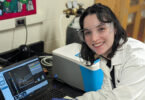Danielle Webster gathers eggs every day, but not from chickens. Walking between towering racks of aquariums, the cellular biology doctoral student must alternately stoop and stretch to collect the embryos of the small, striped zebrafish (Danio rerio).
Zebrafish are prolific—a single female can produce 200 eggs or more per week—and their embryos are transparent and grow fast. In just 72 hours a single cell becomes a see-through swimming larvae, making this freshwater fish from northern India a popular alternative to mice and rats for studying how organisms take on form and shape. Now UGA has a large new laboratory in the Paul D. Coverdell Center for Biomedical and Health Sciences specifically designed for these aquatic animals.
“You can actually see blood flowing through the fish about 30 hours after fertilization through a dissecting scope,” said Webster, who hails from Kingston, Jamaica. “Every structure in the embryo, including the brain, heart and notochord (a line of cells underlying the spinal chord) are very clear to see. This is completely amazing to me.”
The new facility, which houses 1,200 tanks containing up to 30 fish each, can hold up to 1,000 different fish stocks. Each fish stock represents a genetically distinct strain, according to cellular biologist Scott Dougan, who runs the lab. He cross-breeds thousands of fish over several generations, looking for mutations that affect the way body structures such as the muscles, skeleton and skin differentiate at various early stages. In the transparent embryos, any changes are quickly apparent.
“We can see which tissues are absent in all our mutants simply by looking at the fish,” Dougan said. “In some cases we can see the defects quite early.”
Because zebrafish genes have functions similar or identical to those of humans, identifying how those genes affect cells may someday help prevent birth defects and treat cancer and other diseases.
For now, Dougan revels in the additional freedom that the new lab, the construction of which was supported by the Office of the Vice President for Public Research, provides. Formerly squeezed into a small, poorly configured room where much of the maintenance work was done manually, the new facility features an automated system that adjusts pH and water levels.
“The water recirculating system that we have is on par with some of the best facilities I’ve seen,” said Dougan.
Tanks are set up in racks for easy removal, microinjectors are nearby to insert DNA and/or RNA into the embryo cells for developmental study, and water conditions can be monitored from remote locations via the Internet. The monitoring system even sends researchers an e-mail if the proper environment can’t be maintained.
“The only thing we have to do is feed the fish three times a day,” said Dougan. “And do the research.”







